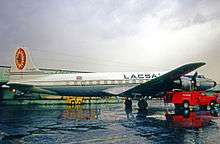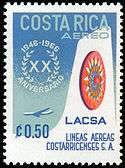Avianca Costa Rica
 | |||||||
| |||||||
| Founded | 1945 | ||||||
|---|---|---|---|---|---|---|---|
| Hubs | Juan Santamaría International Airport | ||||||
| Frequent-flyer program | LifeMiles | ||||||
| Alliance | Star Alliance (affiliate) | ||||||
| Fleet size | 44 | ||||||
| Destinations | 35 | ||||||
| Parent company | Avianca | ||||||
| Headquarters | San José, Costa Rica | ||||||
| Key people |
Roberto Kriete (CEO) Fabio Villegas Ramírez (Chairman & CEO of Holding Company) | ||||||
| Website | www.avianca.com | ||||||
Avianca Costa Rica, formerly known as LACSA (Spanish: Lineas Aéreas Costarricenses S.A.), minority owned by the Synergy Group, is the national airline of Costa Rica and is based in San José. It operates international scheduled services to over 35 destinations in Central, North and South America.[1][2][3] The airline previously used the TACA/LACSA moniker when it was a subsidiary of Grupo TACA. Since May 2013, following Avianca's purchase of Grupo TACA, Avianca Costa Rica became one of seven nationally branded airlines (Avianca Ecuador, Avianca Honduras, etc.) operated by Avianca Holdings group of Latin American airlines.
History

LACSA was established on 17 October 1945 by Pan American World Airways, the Costa Rican government and Costa Rican private interests. It started operations on 1 June 1946 and was designated the national carrier in 1949. Its domestic network was transferred to its wholly owned subsidiary Sansa in September 1959.

LACSA operated the Douglas DC-6B four-engined piston airliner from 1960 until 1976 on their regular passenger, and eventually freight, scheduled flights to Miami International Airport. The airline introduced the first of their British Aircraft Corporation BAC One-Eleven twin-engined jet airliners onto their Caribbean passenger route network in April 1967.[4]
The airline also operated a subsidiary in the Cayman Islands, Cayman Brac Airways (CBA) Ltd.,[5] which it sold a 51% controlling interest in the late 1960s to the Cayman Islands government which in turn used the air carrier to form Cayman Airways. LACSA served Grand Cayman for many years as an intermediate stop on its services between San Jose, Costa Rica and Miami.[6]
Beginning 1998, TACA/LACSA was one of the member airlines comprising the TACA Airlines alliance along with Aviateca of Guatemala, Nica of Nicaragua, Sahsa of Honduras, and five other regional airlines.[7][8] In 2008 a new TACA logo was introduced,[9] followed by a new fleet of Embraer 190 airplanes registered in Costa Rica and operated under the LACSA code. In 2009, Aerovías del Continente Americano S.A. (Avianca) and TACA announced their merger plans to be completed in 2010. By 2013, the airlines began operating as a single commercial brand using the Avianca name. [10]
Destinations
_SJO_04_2005.jpg)

| HUB | |
| Future destination | |
| Terminated destination |
LACSA international destinations in 1973
According to the May 31, 1973 LACSA system timetable, the airline was serving the following international destinations:[11]
- Barranquilla, Colombia
- Caracas, Venezuela
- Grand Cayman, Cayman Islands
- Maracaibo, Venezuela
- Mexico City, Mexico
- Miami, Florida
- Panama City, Panama
- San Andres Island, Colombia
- San Jose, Costa Rica - Hub and airline headquarters
- San Salvador, El Salvador
This same timetable states that all international flights were being operated with British Aircraft Corporation BAC One-Eleven twin jets at this time with the exception of the San Jose-San Andres Island route which was being flown with a Convair 440 propliner.
Fleet
LACSA services were previously flown exclusively by Airbus A320 family jetliners drawn from the pooled fleet of the former Grupo TACA. In 2008, a new fleet of Embraer 190 jets was introduced.[12]
Current
| Aircraft | Total | Orders | Passengers | ||
|---|---|---|---|---|---|
| C | Y | Total | |||
| Airbus A319-100 | 4 | — | 12 | 108 | 120 |
| Airbus A320-200 | 27 | — | 12 | 138 | 150 |
| Airbus A321-200 | 2 | — | 12 | 182 | 194 |
| Embraer 190 | 6 | — | 8 | 88 | 96 |
| Total | 39 | 0 | |||
LACSA passenger retired
- Beechcraft 18 (C-45 model)
- Boeing 727-100
- Boeing 727-200
- Boeing 737-200
- British Aircraft Corporation BAC One-Eleven (includes standard version as well as the stretched series 500 model)
- Convair 340
- Convair 440
- Curtiss C-46
- Douglas DC-3
- Douglas DC-6B
LACSA cargo retired
Incidents
On May 23, 1988, a leased Boeing 727-100, registered TI-LRC and operating the route San Jose-Managua-Miami, collided with a fence at the end of the runway in the Juan Santamaría International Airport, crashed at a nearby field next to a highway, and caught fire. The excess of weight in the front part of the airplane was the cause of the accident. There were no fatalities out of the 23 occupants.
On 11 January 1998, LACSA flight 691,[13] an Airbus A320, veered off a runway at San Francisco International Airport during the takeoff roll. The aircraft left the runway at full speed, coming to rest in a field of mud. The runway was closed after the incident, reducing take-off capacity by 50 percent, leading to massive delays at the airport. None of the 122 passengers on board the aircraft sustained injuries, and stayed at a hotel until another aircraft could transport them to their destination, San José, Costa Rica. The cause of the incident was not determined.[14]
References
- ↑ "Our History". Grupo TACA. Retrieved 2010-10-21.
- ↑ "LACSA Lineas Aéreas Costarricenses – Details and Fleet History". Planespotters.net. Retrieved 2010-10-21.
- ↑ "LACSA". Airfleets.net. Retrieved 2010-10-21.
- ↑ Eastwood & Roach, 2004, p. 170
- ↑ http://www.timetableimages.com, May 1, 1965 Cayman Brac Airways system timetable
- ↑ http://www.timetableimages.com, Dec. 1, 1970 LACSA system timetable
- ↑ http://www.aviancaholdings.com/en/history
- ↑ Rohter, Larry (1998-04-15). "A Home-Grown Giant Of Central America". The New York Times. Retrieved 2009-10-21.
- ↑ "Taca lanza nueva imagen y servicios". La Nación (in Spanish). San José. 2008-09-25. Retrieved 2009-10-21.
- ↑ "TACA renueva flota para vuelos al Istmo". La Nación (in Spanish). San José. 2008-10-08. Retrieved 2009-10-21.
- ↑ http://www.timetableimages.com, May 31 1973 LACSA system timetable
- ↑ Delivers First EMBRAER 190 Jet to TACA Airlines
- ↑ "Airliner speeds off runway at S.F. Airport". The San Francisco Chronicle. 1998-01-11.
- ↑ "Airplane gets stuck in mud after veering off San Francisco runway at full speed". CJOnline.com. January 11, 1998. Retrieved 2009-05-17.
- Roach, J (2004). Jet Airliner Production List - Volume 2. The Aviation Hobby Shop.
- Hardy, M. J. (October 1969). "Aviation in Costa Rica". Air Pictorial. Vol. 31 no. 10. pp. 362–365.
External links
| Wikimedia Commons has media related to LACSA. |